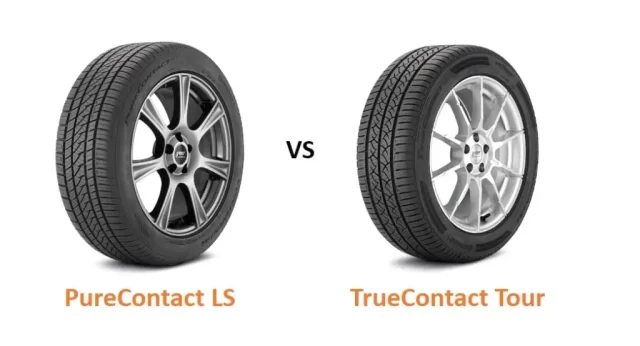Continental Truecontact and Purecontact are both premium summer touring tires that are designed to provide balanced handling and better grip in dry and wet conditions when the temperature is high.
However, they have some differences in their features and performance that may suit different drivers and vehicles. Here are some of the main aspects to compare them:
Continental Truecontact Vs Purecontact
Grip
The grip is the ability of a tire to maintain contact with the road surface and stop quickly when braking. The grip is affected by the contact patch, tread design, and compound of the tire.
The Truecontact has a higher contact patch, which means more surface area of its tread comes in contact with the road. This improves its grip on dry and wet roads and reduces its braking distance.
The Truecontact also has deep and numerous sipes on both the central part and the shoulder blocks of its tread, which enhance its wet grip by creating more biting edges.
The Purecontact has a lower contact patch, which means less surface area of its tread comes in contact with the road. This reduces its grip on dry and wet roads and increases its braking distance.
Purecontact also has inefficient sipes on the central part of its tread, which limit its wet grip by creating fewer biting edges.
Winner: Truecontact
Handling
Handling is the ability of a tire to respond to the steering input and provide stability and control to the vehicle. Handling is affected by the tread design, stiffness, and shape of the tire.
The Truecontact has an asymmetrical four-pitch tread design, which means it has different patterns on the inner and outer sides of the tire. This allows it to adapt to different road conditions and provide optimal performance.
The Truecontact also has compact shoulders and closely positioned shoulder blocks, which increase its stiffness and stability. The Truecontact has a rounder shape, which improves its cornering ability and reduces its rolling resistance.
The Purecontact has an asymmetrical tread design as well, but it has two outer shoulders instead of four pitches. This makes it less adaptable to different road conditions and less optimal in performance.
The Purecontact also has lateral grooves on its outer shoulders, which decrease its stiffness and stability. The Purecontact has a flatter shape, which reduces its cornering ability and increases its rolling resistance.
Winner: Truecontact
Hydroplaning Resistance
Hydroplaning resistance is the ability of a tire to prevent water from building up under its tread and causing loss of traction. Hydroplaning resistance is affected by the tread design, depth, and width of the tire.
The Purecontact has a higher void ratio, which means it has more space between its tread blocks. This allows it to evacuate more water from under its tread and prevent hydroplaning.
The Purecontact also has three wide circumferential grooves that run around its tread, which enhance its water drainage and hydroplaning resistance.
The Truecontact has a lower void ratio, which means it has less space between its tread blocks. This limits its ability to evacuate water from under its tread and increases its risk of hydroplaning.
The Truecontact also has three narrow circumferential grooves that run around its tread, which are less effective in water drainage and hydroplaning resistance.
Winner: Purecontact
Rolling Resistance
Rolling resistance is the force that opposes the motion of a tire when it rolls on a surface. Rolling resistance affects the fuel efficiency, noise level, and wear rate of a tire.
The Purecontact has a low-rolling resistance compound that consists of silica. This reduces the friction between the tire and the road surface, which lowers its rolling resistance.
The Purecontact also has a flatter shape, which distributes its weight more evenly over its contact patch, which lowers its rolling resistance as well.
The Truecontact has a standard compound that does not have silica. This increases the friction between the tire and the road surface, which raises its rolling resistance.
The Truecontact also has a rounder shape, which concentrates its weight more on the center of its contact patch, which raises its rolling resistance as well.
Winner: Purecontact
Comfort
Comfort is the level of smoothness and quietness that a tire provides to the driver and passengers. Comfort is affected by the tread design, noise level, vibration level, and ride quality of a tire.
The Purecontact has an independent tread block design, which means it has separate blocks that can move independently from each other.
This reduces the noise level and vibration level of the tire by absorbing shocks and dampening sounds. The Purecontact also has vertical ridges along its grooves, which reduce airflow turbulence and noise generation.
The Truecontact has an interlocking tread block design, which means it has connected blocks that move together as one unit. This increases the noise level and vibration level of the tire by transmitting shocks and amplifying sounds.
The Truecontact does not have vertical ridges along its grooves, which increases airflow turbulence and noise generation.
Winner: Purecontact
Durability & Treadwear
Durability & Treadwear are the measures of how long a tire can last before it needs to be replaced. Durability & Treadwear are affected by the compound, construction, wear rate, warranty, and price of a tire.
The Truecontact has a standard compound that does not have silica. This makes it more resistant to wear and tear than silica-based compounds. The Truecontact also has a stronger construction that consists of two steel belts reinforced by nylon cap plies.
This enhances its durability and prevents punctures and damage. The Truecontact has a lower wear rate than most summer touring tires due to its higher contact patch and rounder shape.
The Truecontact also has a longer warranty than most summer touring tires at 90 000 miles or 6 years (whichever comes first). The Truecontact also has a lower price than most summer touring tires at around $100 per tire.
The Purecontact has a low-rolling resistance compound that consists of silica. This makes it more prone to wear and tear than standard compounds. The Purecontact also has a weaker construction that consists of only one steel belt without nylon cap plies.
This reduces its durability and makes it more vulnerable to punctures and damage. The Purecontact has a higher wear rate than most summer touring tires due to its lower contact patch and flatter shape.
The Purecontact also has a shorter warranty than most summer touring tires at 70 000 miles or 6 years (whichever comes first). The Purecontact also has a higher price than most summer touring tires at around $120 per tire.
Winner: Truecontact
Quick Summary: Continental Truecontact Vs Purecontact
To sum up, here are some key points to remember when comparing Continental Truecontact vs Purecontact:
1. Both are premium summer touring tires that are built to provide balanced handling and better grip in dry and wet conditions when the temperature is high.
2. The dry and wet grip of the Truecontact is superior to that of the Purecontact due to its higher contact patch and deeper sipes.
3. The dry and wet handling of the Truecontact is better than that of the Purecontact due to its four-pitch tread design and compact shoulders.
4. The hydroplaning resistance of the Purecontact is more efficient than that of the Truecontact due to its higher void ratio and wider grooves.
Who is the winner?
The Truecontact is a more durable, grippy, and stable tire than the Purecontact, but the Purecontact is a more comfortable, fuel-efficient, and hydroplaning-resistant tire than the Truecontact.





